Understand the Purpose of a PR Assistant Cover Letter
A PR assistant cover letter is your initial introduction to a potential employer, and it’s your opportunity to make a strong first impression. It’s not just a formality; it’s a crucial document that can significantly impact your chances of landing an interview. The primary purpose of a cover letter is to highlight your relevant skills, experience, and enthusiasm for the position while showcasing your understanding of the company and its needs. It allows you to go beyond the basic information provided in your resume and demonstrate why you are the ideal candidate for the role. Think of it as your personal pitch, designed to convince the hiring manager that you are worth a closer look.
Why a Cover Letter is Crucial for PR Assistants
In the competitive field of public relations, where effective communication is paramount, a well-crafted cover letter becomes even more important. It demonstrates your writing skills, your attention to detail, and your ability to tailor your message to a specific audience – all critical attributes for a PR assistant. A compelling cover letter can differentiate you from other applicants, especially if you have limited professional experience. It’s a chance to show your personality, your passion for the industry, and your understanding of the specific company. Furthermore, it allows you to address any potential gaps in your resume, such as a career change or a lack of direct PR experience, by explaining how your transferable skills make you a strong fit.
What to Include in a Cover Letter
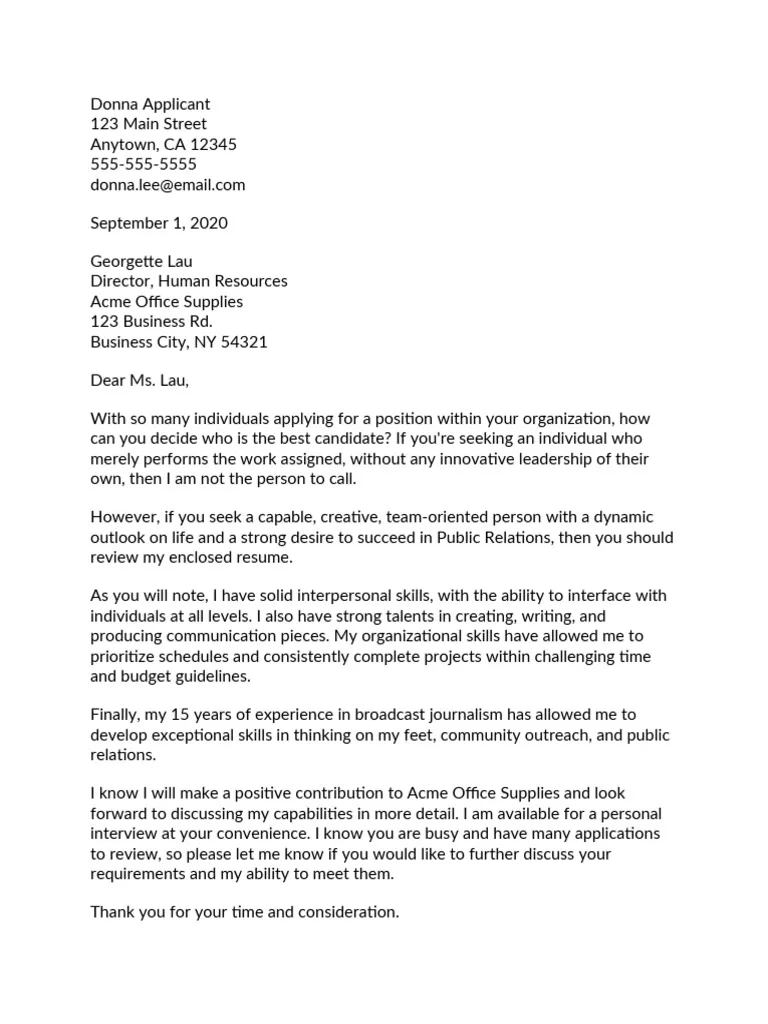
Your Contact Information and Date
At the top of your cover letter, clearly state your contact information, including your full name, phone number, email address, and LinkedIn profile URL if you have one. Include the date you are submitting the cover letter. This information makes it easy for the hiring manager to reach you and adds a professional touch to your document. Ensure the information is accurate and up-to-date, as any errors can create a negative impression. Consider using a simple, clean format to present this information, making it visually appealing and easy to find. Double-check the information for any typos or inconsistencies before submitting your application.
Addressing the Hiring Manager
Whenever possible, address the hiring manager by name. Research the company and look for the name of the person responsible for hiring PR assistants. A personalized salutation shows that you’ve taken the time to learn about the company and the role. If you can’t find a specific name, using a general salutation like ‘Dear Hiring Manager’ or ‘Dear [Company Name] Hiring Team’ is acceptable. Avoid generic greetings like ‘To Whom It May Concern,’ as they can make your application feel impersonal. Remember, the goal is to establish a connection and demonstrate your interest in the specific opportunity.
Opening Paragraph Grab Attention
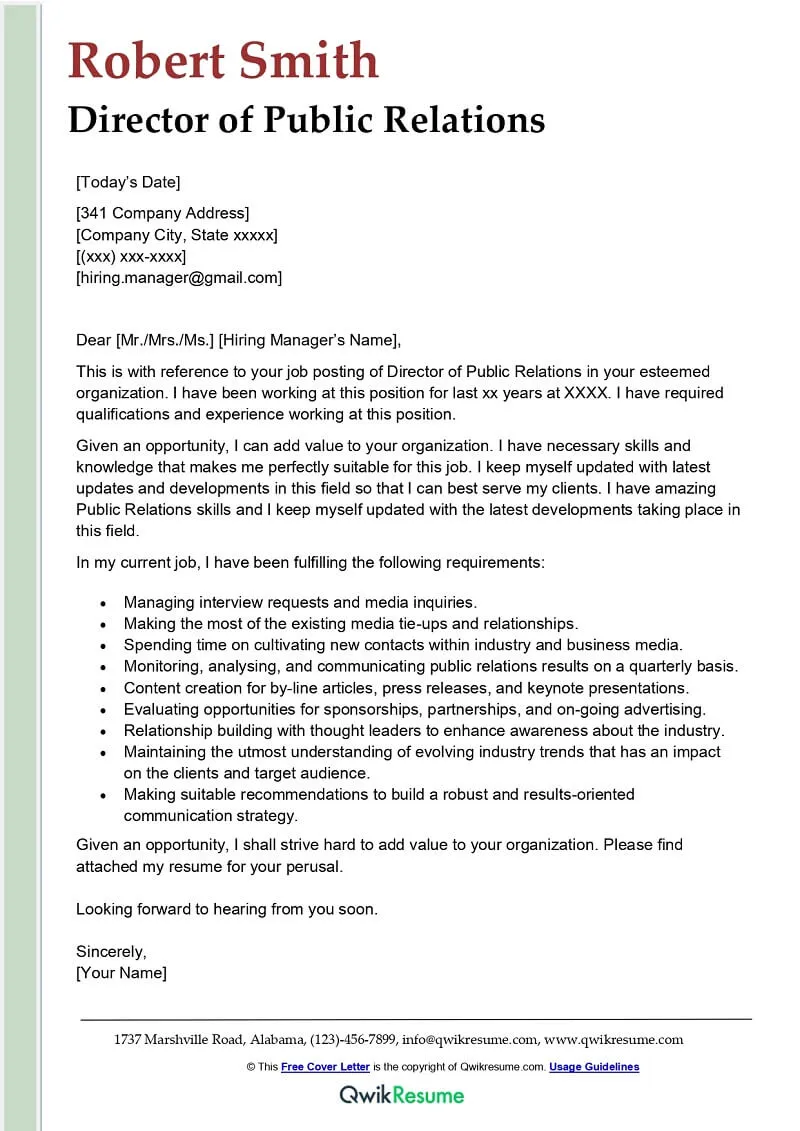
The opening paragraph is your hook; it needs to grab the reader’s attention and make them want to read more. Start with a compelling statement that highlights your enthusiasm for the position or the company. Mention where you found the job posting and why it resonated with you. You might reference a specific project or achievement that demonstrates your relevant skills. Avoid generic openings, such as simply stating you are applying for the PR assistant role. Instead, use an engaging opening that sets the tone for the rest of your letter, showing that you are a proactive and enthusiastic candidate.
Highlight Your Skills and Experience
The body of your cover letter is where you showcase your skills and experience. Focus on the qualifications mentioned in the job description, providing specific examples of how you’ve demonstrated those skills in the past. Use action verbs to describe your accomplishments and quantify your achievements whenever possible. Tailor your examples to the specific requirements of the role; for instance, if the job emphasizes media relations, highlight your experience in writing press releases or pitching stories to journalists. This section should provide a clear picture of your capabilities and how you can contribute to the company’s success. Be concise and focus on the most relevant information.
Mention Relevant Projects and Achievements
Include specific projects or achievements that demonstrate your skills and experience. Instead of simply listing your responsibilities, describe your contributions to a successful campaign, a positive media placement, or an increase in social media engagement. Quantify your results whenever possible; for example, ‘Increased social media followers by 20% in six months’ or ‘Secured coverage in three major publications’. These quantifiable results will make a stronger impression and prove the value you can bring to the role. Ensure that the achievements are relevant to the PR assistant position and demonstrate your ability to achieve company goals.
Showcase Your Passion and Enthusiasm
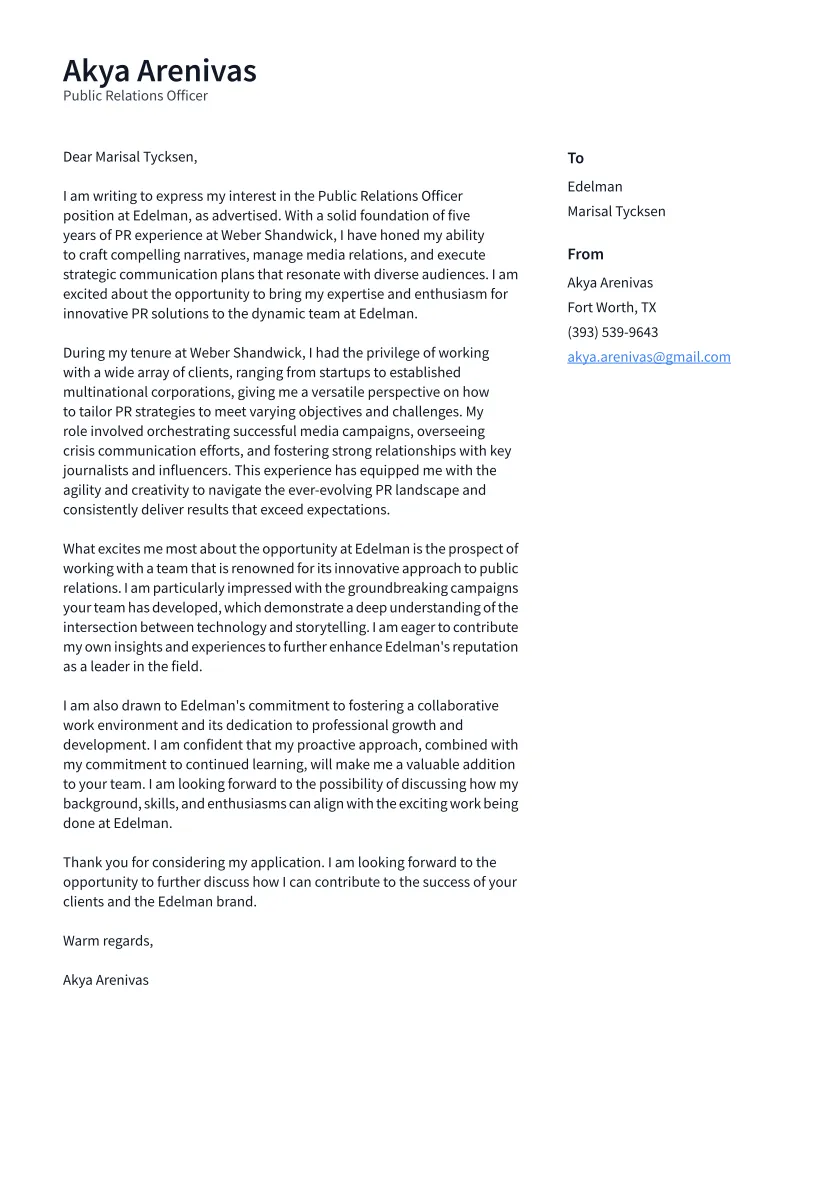
Express your genuine passion for public relations and your enthusiasm for the specific company. Explain what interests you about the company’s mission, values, or recent campaigns. This shows that you’ve done your research and are truly interested in the opportunity. Demonstrate your understanding of the company’s industry and its position in the market. Mention any specific projects or initiatives that have inspired you. Your enthusiasm will help you stand out from other applicants and make a memorable impression. Keep your tone professional yet enthusiastic, demonstrating why you are excited about the role.
Express Your Interest and Next Steps
In your closing paragraph, reiterate your interest in the position and thank the hiring manager for their time and consideration. Express your eagerness to discuss your qualifications further in an interview. Provide your contact information again and state your availability. If the job posting specifies how to apply, follow those instructions precisely. A clear and concise closing demonstrates your professionalism and leaves a positive final impression, encouraging the hiring manager to contact you for the next step.
Formatting and Design Tips for Cover Letters
Choose a Professional Font and Format
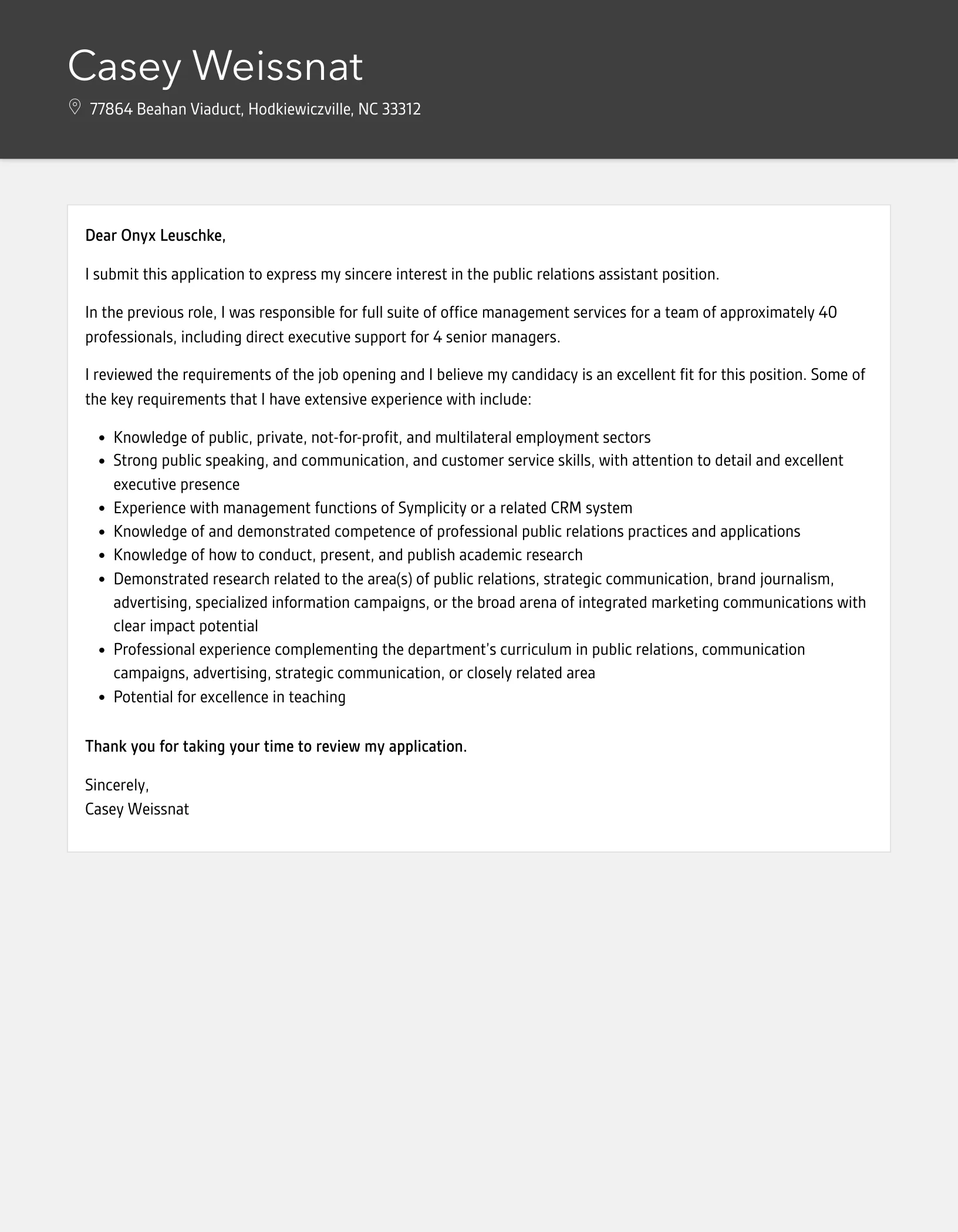
Your cover letter’s appearance is as important as its content. Choose a professional font like Times New Roman, Arial, or Calibri, and use a font size of 11 or 12 points for easy readability. Use standard margins (1 inch on all sides) and single-space the text. Ensure your formatting is consistent throughout the document. Use bullet points to highlight key skills or achievements, but avoid excessive use. The goal is to create a clean, uncluttered layout that is easy for the hiring manager to read and review. Your layout should show that you value clarity and professionalism.
Proofread and Edit Your Cover Letter
Before submitting your cover letter, meticulously proofread and edit it for any grammatical errors, typos, or formatting inconsistencies. Have a friend or family member review it as well. Errors can undermine your credibility and professionalism. Use grammar and spell-check tools, but don’t rely on them entirely. Read your cover letter aloud to catch any awkward phrasing or sentences that don’t flow well. Ensure that your cover letter is polished and reflects your attention to detail. Taking this step can make a significant difference in the hiring manager’s perception of your application.
Tailor Your Cover Letter to the Job Description
Research the Company and Its Values
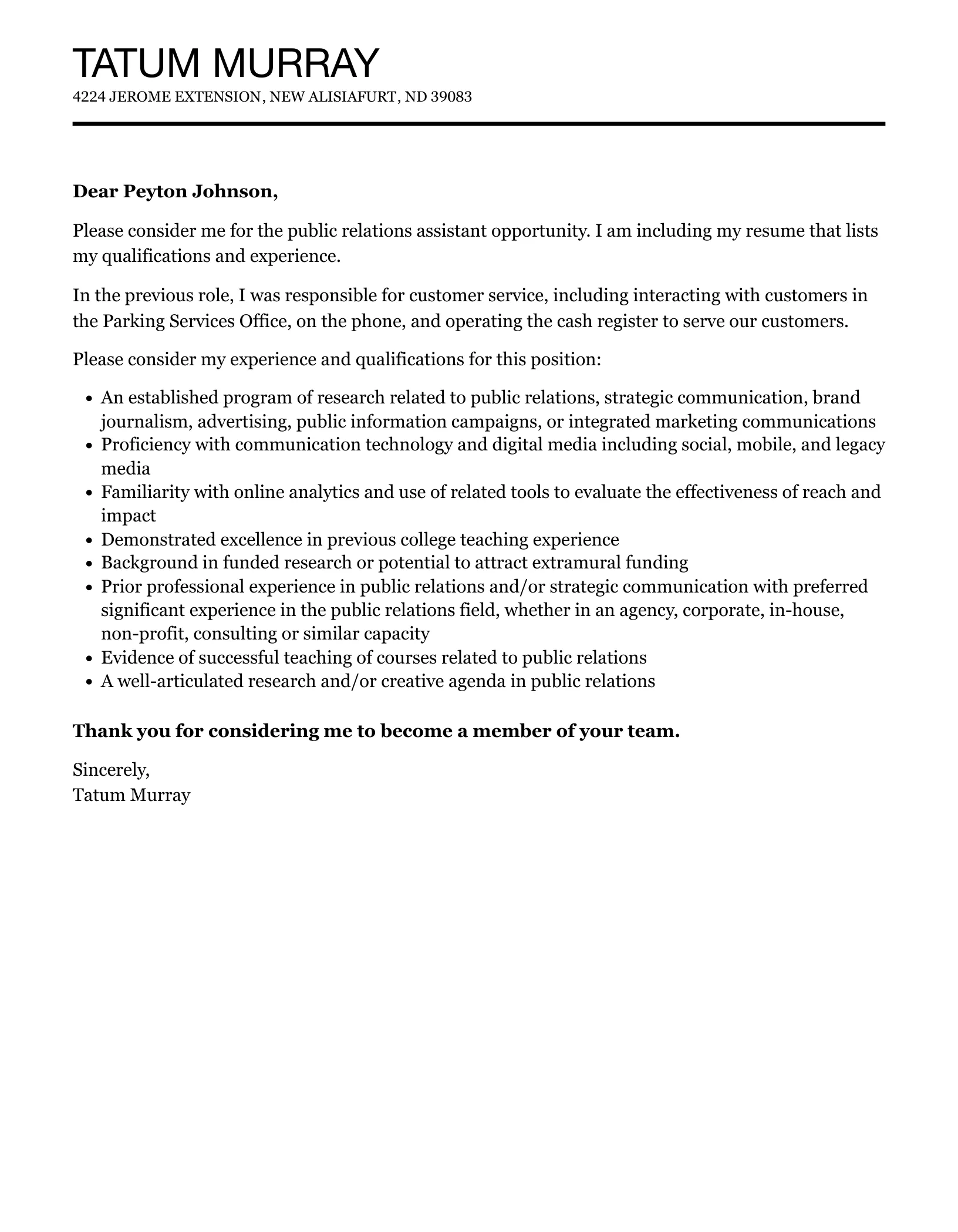
Thoroughly research the company and its values before writing your cover letter. Understand the company’s mission, its recent activities, and its culture. Visit the company website, read their social media profiles, and check out any recent press releases. This knowledge allows you to tailor your cover letter to align with the company’s values and demonstrate your genuine interest. Mention specific company initiatives or campaigns that resonate with you. Show that you understand the company’s goals and how you can contribute to them. Showing that you are invested in the company’s success will increase your chances of getting hired.
Match Your Skills to the Job Requirements
Carefully review the job description and identify the key skills and qualifications the employer is seeking. Then, tailor your cover letter to match those requirements. Highlight the skills and experiences that align with the job description. Use the same keywords and phrases used in the job posting. Provide specific examples of how you have demonstrated these skills in your previous roles or projects. Showing a clear correlation between your qualifications and the job requirements will make your application more compelling and increase your chances of getting an interview. Focus on what you can bring to the company and how your skills can help them achieve their goals.
Examples of Strong Cover Letter Phrases
Showcase Your Communication Skills
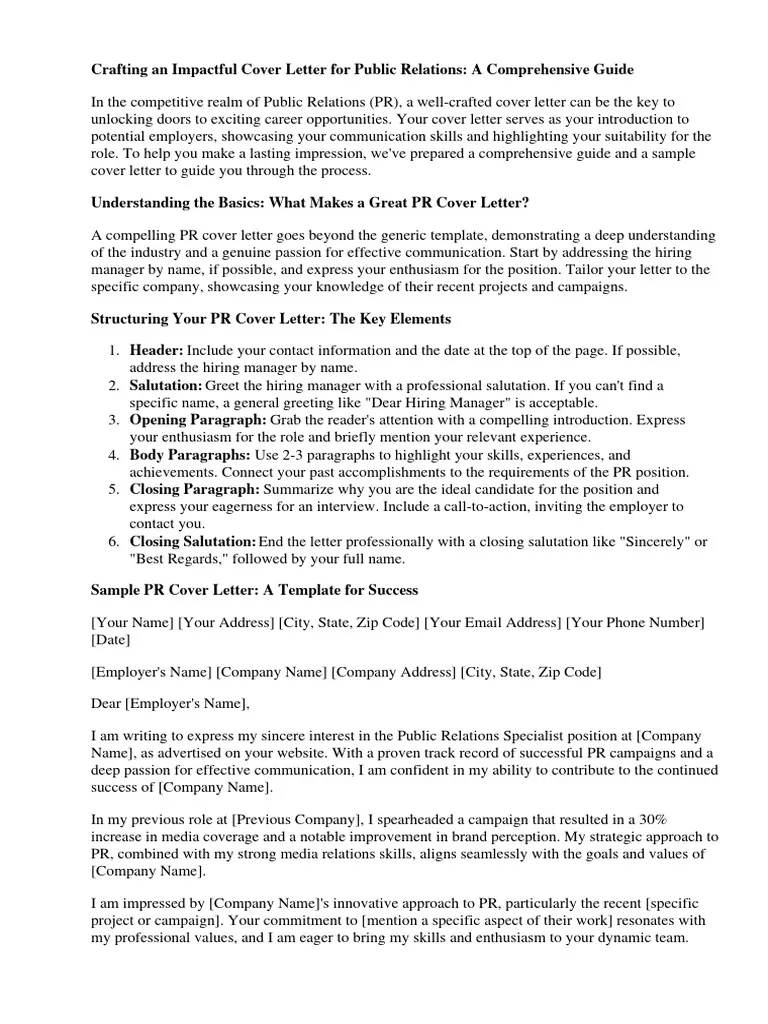
Use strong phrases that showcase your communication skills. For example, instead of saying ‘I have good communication skills,’ use phrases like ‘Proficient in written and verbal communication,’ ‘Developed and delivered compelling presentations,’ or ‘Successfully managed media relations.’ These specific phrases demonstrate your ability to communicate effectively. Highlight your experience in writing press releases, crafting social media content, or interacting with journalists. Choose phrases that highlight your particular strengths and the specific requirements of the PR assistant position. The goal is to show your ability to communicate professionally and effectively.
Demonstrate Your Organizational Abilities
Emphasize your organizational abilities with phrases that demonstrate your efficiency and attention to detail. Instead of ‘I am organized,’ try ‘Managed multiple projects simultaneously, meeting all deadlines,’ ‘Developed and maintained organized media contact lists,’ or ‘Successfully coordinated events with meticulous attention to detail.’ Using such phrases highlights your ability to manage tasks, prioritize projects, and meet deadlines, which are critical skills for a PR assistant. Show that you can juggle multiple responsibilities and stay organized under pressure.
Highlight Your Understanding of PR
Demonstrate your understanding of public relations by using relevant industry terminology and phrases. For instance, instead of ‘I know about PR,’ say ‘Experienced in developing and implementing PR strategies,’ ‘Familiar with media monitoring and analysis,’ or ‘Proven ability to build and maintain relationships with journalists.’ Use phrases that reflect your knowledge of the PR landscape. Show that you understand the industry’s best practices and are familiar with the tools and techniques used by PR professionals. Highlighting your understanding of PR principles will show that you are prepared to contribute to the team’s success.
Review and Submit Your Cover Letter
Before submitting your cover letter, review it one final time. Ensure that your contact information is correct, that you have tailored the letter to the specific job, and that there are no errors. Print a physical copy of your cover letter and read it aloud to catch any awkward phrasing. Ensure you’ve addressed the hiring manager by name and that your tone is professional yet enthusiastic. Make sure your cover letter is a reflection of your best self. Once you are satisfied, save it as a PDF to preserve its formatting and submit it with your application. Doing this gives you the best chance to make a great first impression.
